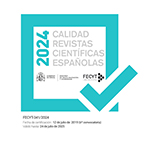Intertextual dialogue in Patrizia Monaco’s "Penelopeide"
Abstract
«I do not like the role that History gave me», says Penelope, the protagonist of Patrizia Monaco’s Penelopeide. For that reason, she decides to break with the secular silence: she does neither accept to be presented as a model of conjugal fidelity, nor as a libertine. Her story is much more complex. The questions that lie in the background, and which this work intends to respond, are: What is true and what is fiction in the story of the myth that has been transmitted to us? What are the boundaries, so faded and vague, between vital experience and mythological world? In order to tell us the story of Penelope, the Italian playwright Patrizia Monaco blends different readings that we intend here to analyze: Homer’s version, different post-classical versions, the perspective followed by Margaret Atwood in Penelopiad, and poems by Cavafy and Sappho. In this way, Monaco introduces us to a different Penelope, deeply human—a woman who has much to say even in the twenty-first century.
Downloads
Article download
License
In order to support the global exchange of knowledge, the journal Cuadernos de Filología Italiana is allowing unrestricted access to its content as from its publication in this electronic edition, and as such it is an open-access journal. The originals published in this journal are the property of the Complutense University of Madrid and any reproduction thereof in full or in part must cite the source. All content is distributed under a Creative Commons Attribution 4.0 use and distribution licence (CC BY 4.0). This circumstance must be expressly stated in these terms where necessary. You can view the summary and the complete legal text of the licence.










